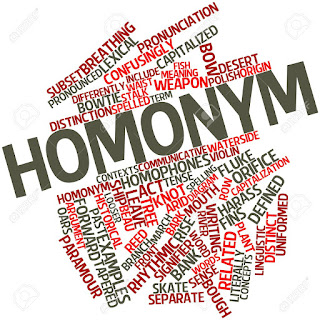Definitions
Homonyms are two or more
words that have the same sound or spelling but differ in meaning. Adjectives: homonymic
and homonymous.
Generally, the term homonym
refers both to homophones (words that are pronounced the same but have
different meanings, such as pair and pear) and to homographs (words that are
spelled the same but have different meanings, such as "bow your
head" and "tied in a bow").
Note that some dictionaries and
textbooks define and distinguish these three terms in different ways. Some
equate homonyms only with homophones (words that sound the same). Others equate
homonymns only with homographs (words that look the same). See the observations
below by Tom McArthur and David Rothwell. Also see Homophones and
Homographs: An American Dictionary, 4th ed., by James B. Hobbs (McFarland
& Company, 2006).
In linguistics, a homonym is one of a group of words
that share the same pronunciation but have different meanings, whether spelled
the same or not. A more restrictive definition sees homonyms as words that are
simultaneously homographs (words that share
the same spelling, regardless of their pronunciation) andhomophones (words that share
the same pronunciation, regardless of their spelling). The relationship between
a set of homonyms is called homonymy.
Examples of homonyms are the pair stalk (part of a plant) and stalk
(follow/harass a person) and the pair left (past tense of leave) and left
(opposite of right). A distinction is sometimes made between "true"
homonyms, which are unrelated in origin, such as skate (glide on ice)
and skate (the fish), and polysemous homonyms, or polysemes, which have a shared
origin, such as mouth (of a river) and mouth (of an animal).
In non-technical contexts, the term
"homonym" may be used (somewhat confusingly) to refer to words that
are either homographs or homophones. The words row (propel with
oars) and row (argument) and row (a linear arrangement of
seating) are considered homographs, while the words read (peruse) and reed
(waterside plant) would be considered homophones; under this looser definition,
both groups of words represent groups of homonyms.
Example Homonym
Homonym
|
Contoh Kalimat Homonym
|
bat (noun = kelelawar)
bat (noun = pemukul) |
Bats may have
rabies like dogs or cats.
(Kelelawar mungkin rabies seperti anjing atau kucing.) |
The boy hit a thief with an aluminium baseball bat
last night.
(Anak itu memukul seorang pencuri dengan tongkat baseball aluminium semalam.) |
|
can (modal = dapat)
can (noun = kaleng) |
I can‘t make up my mind whether to buy a car
or house.
(Saya tidak dapat memutuskan membeli mobil atau rumah.) |
That can may made of aluminium.
(Kaleng itu mungkin terbuat dari aluminium.) |
|
fine (adjective = bagus)
fine (noun = denda) |
She looked fine yesterday.
(Dia tampak baik kemarin.) |
You should pay the fine or go to the court.
(Kamu harus membayar denda atau pergi ke pengadilan.) |
|
left (past tense = meninggalkan)
left (adverb = kiri) |
He left the room 30 minutes ago.
(Dia meninggalkan ruangan 30 menit yang lalu.) |
Turn left at the post office.
(Belok kiri di kantor pos.) |
|
light (noun =
lampu)
light (adjective = terang) |
The hurricane damaged many traffic lights.
(Angin topan merusak banyak lampu lalu lintas.) |
I prefer a light color for my furniture.
(Saya lebih suka warna yang terang untuk mebel.) |
|
match (noun =
geretan)
match (noun = pertandingan) |
He can light a fire with one match.
(Dia dapat menyalakan api dengan satu korek.) |
I’ll watch the live match online.
(Saya akan menonton pertandingan langsung itu secara online.) |
|
stalk (noun =
tangkai, batang)
stalk (verb = mengikuti) |
This vegetable has grayish-green stalks.
(Sayuran ini mempunyai batang hijau keabu-abuan.) |
I’m not interested to stalk him on facebook
or twitter.
(Saya tidak tertarik untuk mengamatinya di facebook atau twitter.) |
|
tie (verb =
mengikat)
tie (noun = dasi) |
My friend tied the box with a red ribbon.
(Teman saya mengikat kotak itu dengan pita merah.) |
He wanted to know how to put a tie on
properly.
(Dia ingin tau bagaimana memakai dasi dengan benar.) |
- Accept (to receive) and Except (excluding)
- Acts (things done) and Ax (chopping tool)
- Ad (advertisement) and Add (short for addition)
- Affect (to influence) and Effect (result)
- Aid (to assist) and Aide (an assistant)
- Air (stuff we breath) and Heir (one who will inherit)
- Aisle (walkway) and Isle (island)
- Allusion (an indirect reference) and Illusion (a misconception)
- Ant (insect) and Aunt (parent's sister)
- Bald (hairless) and Bawled (cried aloud)
- Band (a group) and Banned (forbidden)
- Capital (city) and Capitol (wealth and resources)
- Climactic (great intensity) and Climatic (weather conditions)
- Days (more than one day) and Daze (to bewilder)
- Die (to become dead) and Dye (coloring agent)
- Elicit (to bring out) and Illicit (unlawful)
- Emigrate from (leave one country) and Immigrate to (enter another country)
- Fair (even-handed) and Fare (payment)
- Fairy (imaginary magic person) and Ferry (river-crossing boat)
- Gilt (gold-plated) and Guilt (did wrong)
- Gorilla (large ape) and Guerrilla (military soldier)
- Knead (working bread dough) and Need (must have)
- Mail (postal delivery) and Male (masculine person)
- Principle (a basic truth) and Principal (head of a school/sum of money)
- Scene (visual location) and Seen (past tense of saw)
- Than (a comparison) and then (shows time)
- There (a place) and Their (belongs to them) and They're (they are)
- To (a preposition) and Too (an adverb) and Two (a number)
- Your (possessive pronoun) and You're (you are)
References




Tidak ada komentar:
Posting Komentar